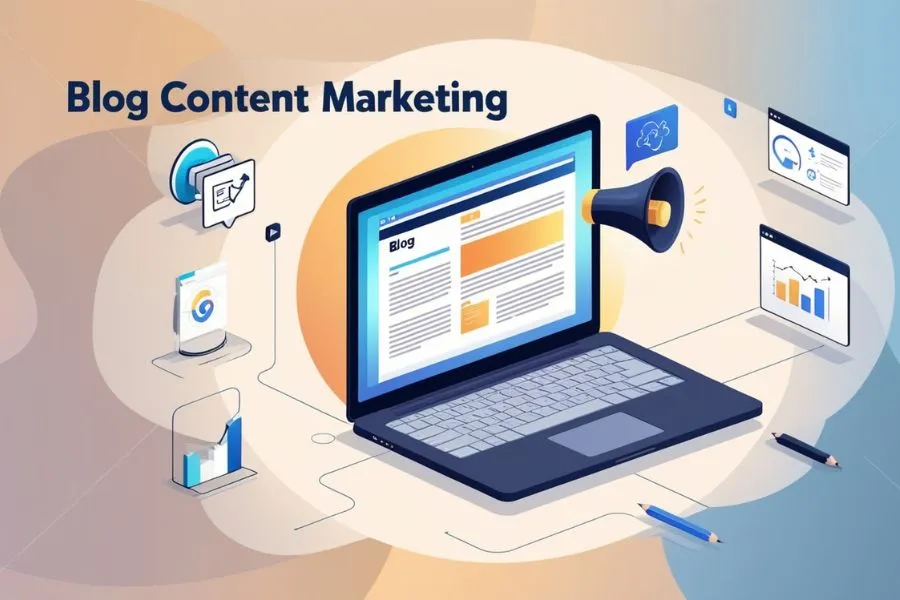Introduction
In today’s digital age, blog content marketing is one of the most effective strategies to boost brand awareness, drive traffic, & engage audiences. Whether you’re a business owner, freelancer, or blogger, mastering blog writing and storytelling can set you apart. Combine this with niche topics and evergreen content, and you’ll have a blog that not only ranks but resonates. This guide dives into actionable blog content marketing strategies, focusing on optimizing blogs with storytelling, niche topics, and SEO techniques.
What is Blog Content Marketing?

The Evolution of Blogging
Blogging started as a digital journal, but today it’s a key component of content marketing strategies for businesses and individuals alike.
Why Content Marketing Matters in Blogging
Blog content marketing uses valuable, targeted, and consistent content to attract and retain readers. It builds relationships, drives conversions, & establishes authority.
The Role of Blog Writing in Content Marketing
Understanding High-Quality Blog Writing
Good blog writing isn’t only words but also delivering value. Use clear language, actionable insights, and a conversational tone. Readers should walk away with something useful.
Storytelling: The Secret Sauce in Blog Content Marketing
What Makes Storytelling Powerful?
People connect with stories, not facts. By telling stories, you create an emotional connection with readers, which keeps them coming back.
How to Weave Stories into Blog Writing
- Use personal anecdotes.
- Share client or customer success stories.
- Add narrative elements: characters, conflict, and resolution.
Examples of Brands Using Storytelling
- Airbnb: Their blog shares traveler stories, building trust and inspiring adventures.
Focusing on Niche Topics: Why Specificity Wins
Defining Your Niche
A niche topic relates to a specific area of expertise. For example, instead of writing about “Exercise” you could write about “Exercise tips for in free hours.”
Finding the Right Niche for Your Audience
Use the below tools to find niche topics your audience cares about.
| 1. Google Trends | 2. AnswerThePublic | 3. SEMrush |
Benefits of Niche Blog Content
- Attracts targeted readers.
- Increases engagement and conversions.
- Build authority in your relevant niche.
Evergreen Content: The Backbone of Successful Blogs
What is Evergreen Content?
Evergreen content remains relevant & valuable, driving traffic. Examples include:
1. “How-to” guides
- Cooking: “How to Make the Perfect Omelet”
- Finance: “How to Budget Effectively”
- Fitness: “How to Start a Home Workout Routine”
2. FAQs
- Travel: “Frequently Asked Questions About Traveling to [Destination]”
- Health: “Common Health Questions Answered”
3. Ultimate resource lists
- Marketing: “The Ultimate List of Marketing Tools and Resources”
- Writing: “The Best Writing Tools and Tips”
Benefits of Evergreen Content for Long-Term Traffic
It requires minimal updates and continually attracts organic traffic.
Blog Optimization: Making Your Content Work Smarter

SEO Basics for Blogs
- Use primary keywords like “blog content marketing” naturally.
- Add LSI keywords in blog along with your focus keywords like “storytelling”, “blog writing” & “blog optimization.”
On-Page SEO Essentials
- Use proper headers (H1, H2, H3).
- Add internal and external links.
- Optimize images with alt text.
Blog Optimization Tools and Plugins
- Yoast SEO/Rank Math: For WordPress blogs.
- Google Search Console: To monitor blog performance.
Creating an Effective Blog Content Strategy
Step 1: Identifying Your Audience
Understand for whom you are writing, and what are their needs.
Example:
- Niche: Fitness and Wellness
- Target Audience: Busy professionals aged 25-45 who want to improve their health but struggle to find time for exercise.
Understanding their pain points:
- Lack of time for workouts
- Difficulty maintaining a healthy diet
- Feeling overwhelmed by fitness information
Step 2: Choosing Content Themes
Create blog categories based on your niche.
Based on the target audience above, here are some potential blog categories:
- Quick Workouts: Short, effective workouts that can be done anywhere.
- Healthy Eating: Easy-to-follow meal plans and recipes.
- Mindfulness and Stress Relief: Techniques for managing stress and improving mental health.
- Fitness Myths Debunked: Dispelling common misconceptions about fitness and health.
Step 3: Maintaining a Content Calendar
Consistency is key. Use tools like Trello or Asana to plan blog posts.
Using a tool like Trello, you could create a board with the following lists:
- Ideas: Brainstorming new blog post ideas.
- In Progress: Posts currently being written or edited.
- Scheduled: Posts ready to be published on specific dates.
- Published: Archived posts for reference.
Example Content Calendar:
| Week 1 | Week 2 | Week 3 | Week 4 |
| Quick Workout for Busy Mornings | Healthy Lunch Ideas for the Office | Mindfulness Techniques for Stress Relief | Debunking the Myth of No-Carb Diets |
Content Strategy: A Step-by-Step Guide to Effective Content Planning
Top Tools for Blog Writing and Optimization
- Grammarly: Improve blog grammar.
Example: Use Grammarly’s suggestions to enhance sentence structure and clarity, making your writing more engaging for your readers.
- Ahrefs: Find niche keywords and track backlinks.
Example: Conduct keyword research to identify relevant keywords and phrases that your target audience is searching for. Use Ahrefs’ Keyword Explorer to find high-traffic, low-competition keywords to optimize your blog posts.
- Google Analytics: Track your blog’s performance.
Example: Check your blog’s performance, such as page views, bounce rate & unique visitors. Use Google Analytics to identify which blog posts are most popular with your audience and which ones need improvement.
Tips for Sustaining Blog Content Marketing Success
- Update old posts with new information.
- Diversify content with videos and infographics.
- Listen to your audience’s feedback.
Conclusion
Blog content marketing is all about combining storytelling, niche topics, evergreen content, and smart SEO techniques. By creating value-driven content, telling relatable stories, and optimizing for search engines, you can build a blog that captivates audiences and ranks on Google.
FAQs
1. What is blog content marketing?
Blog content marketing uses valuable content to engage audiences and drive traffic to your website.
2. Why is storytelling important in blogging?
Storytelling creates emotional connections, making your content memorable and engaging.
3. What are niche topics in blogging?
Niche topics are focused areas of content tailored to a specific audience or interest.
4. How does evergreen content benefit blogs?
Evergreen content attracts consistent traffic because it remains relevant over time.
5. What tools can I use for blog optimization?
Tools like Yoast SEO, Grammarly, and Google Analytics help optimize blog performance.

